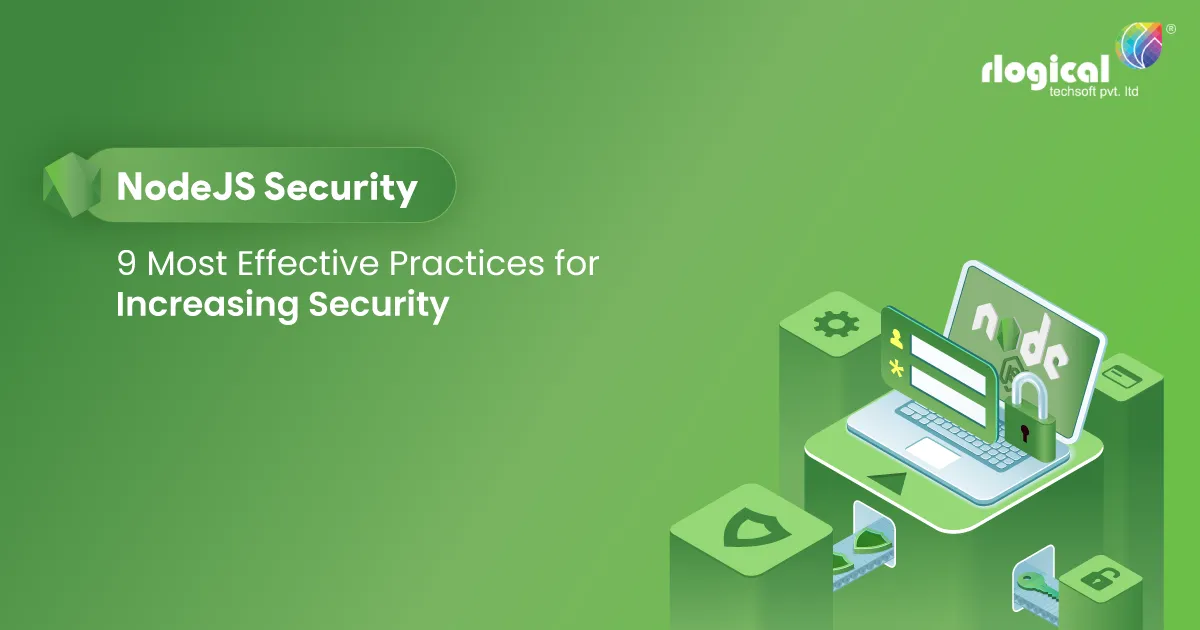connection.query('SELECT * FROM orders WHERE id = ' + id, function (error, results, fields) {
if (error) throw error;
// ...
});

There is no doubt that Node JS is becoming increasingly popular during the last several years. It is being used by big companies such as eBay, Twitter, PayPal, and Netflix to power their backends and take care of the increasing traffic. Moreover, startups are also not trailing behind since They have adopted Node JS to create their websites.
In this article, we have shared several of the best practices around this framework, particularly security. These practices should be followed while working with Node JS, irrespective of whether you happen to be a freelancer or working with an in-house team.
1. Validate input from the user for limiting SQL injections as well as XSS attacks
One of the most well-known attacks happens to be SQL injection. One can consider it to be amongst the most typical security issues concerning Node JS. Every programmer must consider the most effective practices for solving this problem.
The SQL injection attack will typically take place once the hacker can implement the SQL statement. It becomes feasible once you do not sanitize the input from the front end. One can also consider it to be the Node JS parameter or backend from the data provided by the user, and it is used as a part of the SQL statement directly.
The fundamental concept that must be followed at the time of these attacks is not to pass the parameters blindly to the database query from the front end. Instead, make it a point to escape or validate the values provided by the user.
Apart from this, it will be perceptible that some specific database libraries for this framework are functioning automatically. However, you are always free to go for more generic libraries as an integral part of the Node JS web app security. Meanwhile, one should also bear in mind that cross-site scripting, known as the XSS attacks, functions in the same manner as SQL injection.
Nevertheless, there happens to be a difference in the form that the attack can execute the JavaScript code rather than sending the harmful SQL. The user input has to be validated for solving this issue.
For example:
2. Focus on HTTP Headers
It is a fact that HTTP headers can be useful as well as malicious. Using the incorrect ones or even using the correct ones improperly might result in clickjacking and cross-site scripting. What will be the solution for this? It is not possible to eliminate the HTTP headers. Therefore, any of these two things can be done by you – either make them secure using a Helmet or evaluate them manually after focusing on each one of them.
Although Helmet happens to be comparatively small, it is a potent Node module that will assist you in enhancing header security simply by installing it. Although it can be easily configured to enhance its abilities, that will not be required to get its assistance in removing or including headers.
app.use(helmet());
3. Never make use of a root user for running Node JS
Although this might appear to be a rather basic thing, it is quite surprising that many developers working in web app development companies do not focus on this. If you use root access for running the Node JS code, it will pave the way for any hacker to attack you unexpectedly. Even though it might be easy to use a root user for some particular tasks, some workarounds must be tried by you to avoid this.
Here, we like to mention that you will be exposed to attacks every time you run the code with sudo. Therefore, it will be a sensible idea to use non-root users to run the code.
Must Read: Top 6 Leading Node.JS Frameworks
4. Be cautious while using Eval
If possible, do not make use of Eval whatsoever. It is a fact that it can help make your code much more dynamic, but it would also enable the attackers to harmful input code that will eventually run by your app. Any string of characters can be executed by eval as code, and therefore, it will not be possible for you to be sanguine regarding what type of input the eval statement will be dealing with. This might result in all kinds of security problems, including DoS attacks.
These types of attacks are the worst that you can suffer through eval. It might be the fact that you did not face any problems while using it. In case you are meticulous, it can be used securely without any problem whatsoever. However, the actual problem is that it will be essential for you to focus on lots of details to stay away from the extensive range of issues that might arise.
5. Make use of 2FA for preventing automated attacks
One significant weakness that you might have happens to be an authentication system that is broken. If you implement a weak password and session management policy in your apps, you will be exposed to attackers out there. For this reason, it will be a sensible idea to consider the various aspects coming with authentication – ID management, creation and recovery of passwords, and so forth.
Although you can use solutions such as OAuth to deal with all these, you should be using another thing that happens to be 2FA (two-factor authentication). You can integrate this into your website or app via Yarn packages or NPM while creating one-time tokens for every user.
6. Stay away from errors revealing a lot of things
Next, we will talk about handling errors. Here, you need to consider several essential things. First, do not reveal the details to the user. This is because it might consist of info such as paths that you do not like to expose. Second, wrap routes using the catch clause and do not allow Node JS to crash once a request generates the error. In this way, attackers will not be able to find any malicious request that might make your application crash repeatedly by sending them again and again.
Make it a point not to expose your app directly on the web since this will enhance the possibilities of the Node JS app becoming flooded with spiteful requests. Instead, some components should be used in front of it, like a gateway or cloud firewall or a load balancer. In this way, you will be able to restrict the DoS attacks before they can hit your Node JS app.
7. Run automated vulnerability scanning
It is a fact that there are lots of libraries and modules in the Node JS ecosystem that can be installed. In case you hire NodeJS developers, they will be using many of them in their products. This will create a security issue; you will not be certain it is secure while using code that somebody else has written.
To solve this problem, it will be imperative for you to run automatic vulnerability scans quite frequently. They will aid you in coming across dependences having known vulnerabilities. You can use npm audit for the basic check out there.
8. Set up monitoring and logging
It might appear to you that monitoring and logging might not be essential when it comes to security. However, it is not a fact. The target will be to make everything secure from scratch; however, an ongoing process will be required in reality. Monitoring and logging will be required for this. Although some hackers might intend to make your app unavailable, it will be possible for you to find this out without logging.
Nevertheless, certain hackers might like to remain unidentified for a considerable time. In these types of situations, you will identify that something is incorrect by monitoring metrics and logs. However, only basic logging will not allow you to obtain adequate information for comprehending whether any unusual request is coming from a third-party API, a hacker, or your app.
9. Prevent leakage of data
Although you cannot simply depend on what you are obtaining from the front-end, it will be advisable not to depend on what you will convey information. Instead, you can simply proceed while sending all the info for the particular object easily to the front-end and filtering what will be displayed there. It is quite simple to do this, given that hackers always attempt to find the concealed info sent from the backend.
In this case, the solution that has to be applied by you will be to only send the info required. If you need the first and last names, make certain regarding just recovered from the database. Although you might be required to work a bit more, it is worth it.
Conclusion
All these practices mentioned in this article are only the tip of the iceberg. You can do many more things to enhance your Node JS security. Luckily, you will come across lots of tools and guides that will help you get maximum protection. Although it might seem to be daunting sometimes, it happens to be the safest way to enjoy the remarkable advantages of Node JS without compromising the integrity of your web apps.
Rahul Panchal
Rahul Panchal is a Founder and Managing Director of Rlogical Techsoft Pvt. Ltd, a web & mobile app development company India specialized in Hybrid, Native, Android and iOS App development.
Related Blog
Categories
- All
- Amazon Web Services (AWS)
- ASP.Net Development
- Azure Web App
- Big Data Analytic
- Customize
- Digital Marketing
- Drupal Development
- E-commerce web development
- Education Mobile App Development
- Enterprise Application
- Event Management App Development
- Fintech
- Fitness App Development
- Food Delievery
- Front-End Development
- Healthcare App Development
- Hire Dedicated Developers
- Hotel Booking App
- IT Industry
- JavaScript Development
- Mobile App Development
- On Demand App Development
- On Demand Healthcare App Development
- PHP Development
- POS Software Development
- Real Estate Mobile App Development
- Retail Business App Development
- Salesforce
- Social Media Development
- Software Development
- Technology
- Transportation App Development
- UI/UX Design
- Web Design
- Web Development
- Web Services
- Web/Data Scraping Services
- WordPress
Get in Touch
Contact Us
3728 N Fratney St Suite 213, Milwaukee, WI 53212, United States
Sales Executive: +1 414 253 3132
Contact Email: [email protected]
701 & 801 Satkar Complex, Opp Tanishq Showroom,Behind Lal Bungalow, Chimanlal Girdharlal Rd, Ahmedabad, Gujarat 380009
Rahul Panchal: +91-9824601707
Jatin Panchal: +91-9974202036
Contact Email: [email protected]
301 1-28-21 Hayabuchi, Tsuzuki-ku, Yokohama-shi, Kanagawa 224-0025, Japan
Contact Email: [email protected]



 Rahul Panchal in Hire NodeJs Developers
Rahul Panchal in Hire NodeJs Developers 
